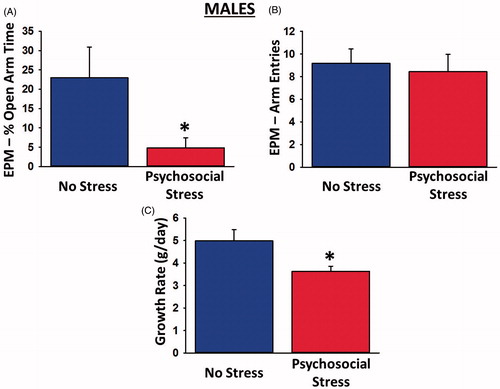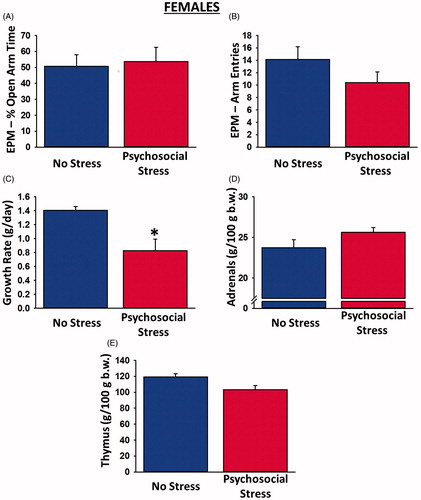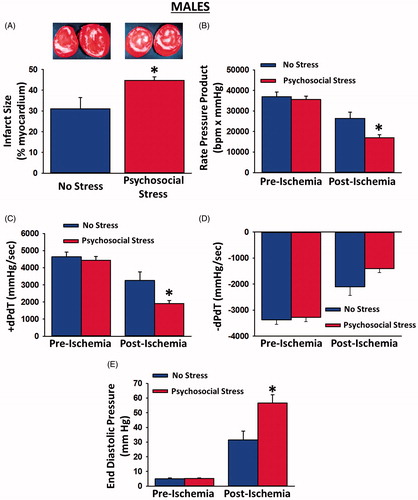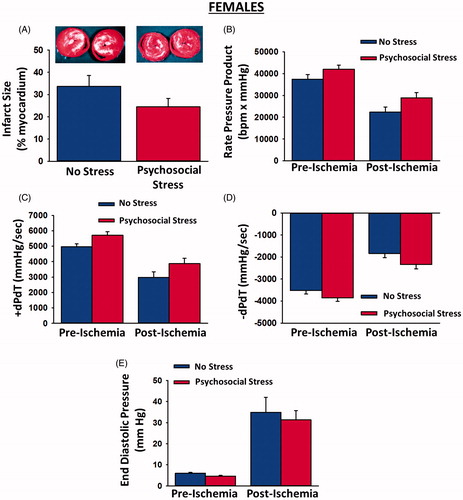Figures & data
Figure 1. Physiological and behavioral effects of psychosocial stress in male rats. Psychosocially stressed males spent significantly less time in the open arms of the elevated plus maze (A), despite making an equivalent numbers of overall arm entries in the maze (B). The stressed males also exhibited significantly reduced growth rates (C) relative to controls. Sample sizes were 9–11 rats per group. Data are presented as means ± SEM. *p < 0.05 versus no stress.

Figure 2. Physiological and behavioral effects of psychosocial stress in female rats. Psychosocially stressed females spent a similar amount of time in the open arms of the elevated plus maze as control rats (A) and made a similar number of overall arm entries in the maze (B), despite exhibiting significantly reduced growth rates (C) relative to controls. There were no significant differences between the adrenal (D) or thymus (E) gland weights of stressed and non-stressed female rats. Sample sizes were 10–14 rats per group. Data are presented as means ± SEM. *p < 0.05 versus no stress.

Figure 3. Myocardial infarct sizes, pre-ischemic contractile function and post-ischemic recovery of contractile function in male hearts exposed to myocardial ischemia. Hearts from psychosocially stressed males exhibited significantly larger infarcts than control hearts (A; insets depict representative myocardial slices with white areas indicative of infarction). There were no differences in pre-ischemic parameters of contractile function between hearts from psychosocially stressed and control males. Recovery of rate pressure product (B) and +dP/dT (C) were significantly attenuated in hearts from psychosocially stressed males, relative to those from controls. Recovery of −dP/dT (D) was borderline significant in hearts from psychosocially stressed males. Recovery of end diastolic pressure (E) was significantly elevated in psychosocially stressed males relative to controls. Samples sizes were 7–9 hearts per group. Data are presented as means ± SEM. *p < 0.05 relative to no stress.

Figure 4. Myocardial infarct sizes, pre-ischemic contractile function and post-ischemic recovery of contractile function in female hearts exposed to myocardial ischemia. Psychosocial stress had no effect on infarct sizes (A; insets depict representative myocardial slices with white areas indicative of infarction) or pre-ischemic contractile function. In addition, post-ischemic recovery of rate pressure product (B), +dp/dT (C), −dP/dT (D) and end diastolic pressure (E) were unaffected by psychosocial stress. Sample sizes were 10–14 hearts per group. Data are presented as means ± SEM.

